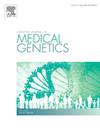部分3q四体:定义综合征,新中心粒,和一个额外的病例报告。
IF 1.7
4区 医学
Q3 GENETICS & HEREDITY
引用次数: 0
摘要
部分3q四体是一种非常罕见的遗传疾病,其表型迄今尚未得到全面的评价。在本文中,我们报告了第18例病例,并对先前发表的病例进行了重新评估。本病例表现为畸形、畸形、认知缺陷、终末期肾病、手术矫正的系索/脊柱侧凸以及皮肤色素改变,23年来一直未被诊断。血液和成纤维细胞核型和外显子组测序结果正常。未培养皮肤活检的染色体微阵列分析显示3q末端34Mb的马赛克扩增。随后对培养细胞的荧光原位杂交显示,少数中期含有一个小的额外标记染色体(sSMC),由扩增的3q材料的两个头对头拷贝组成,具有新中心粒形成,核型中的嵌合程度较低归因于培养时sSMC的丢失。回顾已发表的部分3q四体病病例,我们发现色素改变与Blaschko、认知缺陷、脊柱畸形、鼻桥凹陷和腭畸形是常见的发现,并强调了部分3q三体的表型重叠。症状从轻微到严重,可能取决于放大的大小和镶嵌的程度。本文章由计算机程序翻译,如有差异,请以英文原文为准。
Partial 3q tetrasomy: Defining the syndrome, neocentromeres, and an additional case report
Partial 3q tetrasomy is an ultra-rare genetic condition, with a phenotype that has hitherto not been comprehensively reviewed. In this paper we report the 18th case and re-evaluate those previously published.
The present case presented with dysmorphic features, malformations, cognitive deficits, end-stage renal disease, a surgically corrected tethered chord/scoliosis along with skin pigmentary changes and had remained without a diagnosis for 23 years. Blood and fibroblast karyotyping and exome sequencing yielded a normal result. Chromosomal microarray analysis on uncultured skin biopsies showed a mosaic amplification of the terminal 34 Mb of 3q. Subsequent fluorescence in situ hybridisation on cultured cells showed that a few metaphases contained a small supernumerary marker chromosome (sSMC) consisting of two head-to-head copies of the amplified 3q-material with neocentromere formation, the lower degree of mosaicism in karyotyping being ascribed to loss of sSMC upon culturing.
Reviewing the published cases of partial 3q tetrasomy cases we find pigmentary changes along the lines of Blaschko, cognitive deficits, spinal malformations, depressed nasal bridge, and palatal deformities to be frequent findings, and highlight a phenotypic overlap with partial 3q trisomy. Symptoms spanned from mild to severe, likely depending on both the size of the amplification and the degree of mosaicism.
求助全文
通过发布文献求助,成功后即可免费获取论文全文。
去求助
来源期刊
CiteScore
4.10
自引率
0.00%
发文量
193
审稿时长
66 days
期刊介绍:
The European Journal of Medical Genetics (EJMG) is a peer-reviewed journal that publishes articles in English on various aspects of human and medical genetics and of the genetics of experimental models.
Original clinical and experimental research articles, short clinical reports, review articles and letters to the editor are welcome on topics such as :
• Dysmorphology and syndrome delineation
• Molecular genetics and molecular cytogenetics of inherited disorders
• Clinical applications of genomics and nextgen sequencing technologies
• Syndromal cancer genetics
• Behavioral genetics
• Community genetics
• Fetal pathology and prenatal diagnosis
• Genetic counseling.

 求助内容:
求助内容: 应助结果提醒方式:
应助结果提醒方式:


